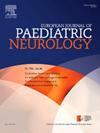Association of 5-HT, ET-1, PTX-3, and inflammatory markers with clinical parameters in pediatric migraine patients with patent foramen ovale
IF 2.3
3区 医学
Q3 CLINICAL NEUROLOGY
引用次数: 0
Abstract
Background
Pediatric migraine is a debilitating neurological disorder frequently associated with patent foramen ovale (PFO). The roles of vasoactive substances (5-HT, ET-1) and inflammatory markers (PTX-3, TNF-α, CRP) in PFO-related pediatric migraine remain unclear. This study aimed to evaluate their predictive value and associations with clinical parameters.
Methods
A prospective cohort study enrolled 149 PFO patients (78 with pediatric migraine, 71 without) and 70 healthy controls. Serum levels of 5-HT, ET-1, PTX-3, TNF-α, PCT, and CRP were measured using ELISA. Clinical data, including pediatric migraine characteristics and PFO features (diameter, right-to-left shunt), were analyzed. Receiver operating characteristic (ROC) curves assessed biomarker performance, and logistic regression identified risk factors.
Results
5-HT showed the highest individual predictive accuracy for pediatric migraine (AUC = 0.810), followed by PCT (AUC = 0.786) and PTX-3 (AUC = 0.707). ET-1 exhibited high specificity (99.1 %), while TNF-α and CRP demonstrated high sensitivity (91.1 %). A combined biomarker panel achieved superior performance (AUC = 0.911, specificity = 94.4 %). Elevated 5-HT (adjusted OR = 1.593, p = 0.026) and PTX-3 (adjusted OR = 1.752, p = 0.014) levels were independently associated with pediatric migraine risk after adjusting for covariates.
Conclusion
5-HT, PTX-3, and inflammatory markers are promising biomarkers for PFO-related pediatric migraine. A multi-marker approach significantly enhances risk prediction, supporting its potential for clinical stratification and targeted interventions.
小儿偏头痛卵圆孔未闭患者5-HT、ET-1、PTX-3及炎症标志物与临床参数的关系
儿童偏头痛是一种衰弱性神经系统疾病,通常与卵圆孔未闭(PFO)相关。血管活性物质(5-HT、ET-1)和炎症标志物(PTX-3、TNF-α、CRP)在pfo相关性儿童偏头痛中的作用尚不清楚。本研究旨在评估其预测价值及其与临床参数的关系。方法一项前瞻性队列研究纳入149例PFO患者(78例患有儿童偏头痛,71例没有)和70名健康对照。采用ELISA法检测血清5-HT、ET-1、PTX-3、TNF-α、PCT、CRP水平。临床资料,包括小儿偏头痛特征和PFO特征(直径,右至左分流)进行分析。受试者工作特征(ROC)曲线评估生物标志物的表现,逻辑回归确定危险因素。结果5- ht对儿童偏头痛的个体预测准确率最高(AUC = 0.810),其次是PCT (AUC = 0.786)和PTX-3 (AUC = 0.707)。ET-1具有高特异性(99.1%),而TNF-α和CRP具有高敏感性(91.1%)。联合生物标志物面板获得了更好的性能(AUC = 0.911,特异性= 94.4%)。校正协变量后,升高的5-HT(校正OR = 1.593, p = 0.026)和PTX-3(校正OR = 1.752, p = 0.014)水平与儿童偏头痛风险独立相关。结论5- ht、PTX-3和炎症标志物是治疗pfo相关性儿童偏头痛的有前景的生物标志物。多标记方法显著提高了风险预测,支持其临床分层和有针对性干预的潜力。
本文章由计算机程序翻译,如有差异,请以英文原文为准。
求助全文
约1分钟内获得全文
求助全文
来源期刊
CiteScore
6.30
自引率
3.20%
发文量
115
审稿时长
81 days
期刊介绍:
The European Journal of Paediatric Neurology is the Official Journal of the European Paediatric Neurology Society, successor to the long-established European Federation of Child Neurology Societies.
Under the guidance of a prestigious International editorial board, this multi-disciplinary journal publishes exciting clinical and experimental research in this rapidly expanding field. High quality papers written by leading experts encompass all the major diseases including epilepsy, movement disorders, neuromuscular disorders, neurodegenerative disorders and intellectual disability.
Other exciting highlights include articles on brain imaging and neonatal neurology, and the publication of regularly updated tables relating to the main groups of disorders.

 求助内容:
求助内容: 应助结果提醒方式:
应助结果提醒方式:


